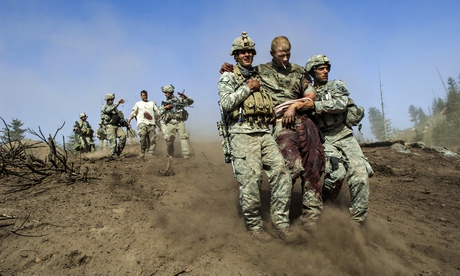
“If your pictures aren’t good enough,” the great war photographer Robert Capa, once said, “you aren’t close enough.” The quotation, in its mixture of self-serving bravado and self-evident truth, has served as an unspoken adage for war photographers ever since. The curious mixture of duty, risk-taking, camaraderie and recklessness that defines the job has been explored with illuminating candour by Don McCullin in his aptly named Unreasonable Behaviour. Now comes Lynsey Addario’s It’s What I Do, a post-9/11 memoir by a female photojournalist torn between the need to bear witness from often dangerous places and the call of family, motherhood and a safer life.
The book begins dramatically in Libya on 15 March 2011, with a description of the moment when the car Addario was travelling in with four companions – her friend and fellow photographer Tyler Hicks, two journalists, Anthony Shadid and Stephen Farrell, and their driver, Mohammed – was stopped at a checkpoint near the besieged town of Ajdabiya by soldiers loyal to Colonel Gaddafi. So began a nightmare that included beatings, death threats and, in Addario’s case, sexual molestation by her captors, before they were released a few days later.
The writing in the opening chapter is taut and to-the-point, but every detail adds to the sense of anxiety. Addario describes how she had experienced a feeling of foreboding throughout her time in Libya and how she had remained there even though many seasoned war correspondents had left the country. She recounts how Mohammed had been “getting frantic” as they lingered amid sniper fire on the road near Ajdabiya and how “Tyler had asked Mohammed to stop the car one last time to check out a team of rebel fighters setting up rocket-propelled grenades”. Here, one senses the heightened, unreal dynamic of war reportage, but also the pull between her own rising panic and her pride and sense of duty to her calling. “I didn’t want to be the cowardly photographer or the terrified girl who prevented the men from doing their work,” she writes.
In the end, though, Addario and her comrades stayed too long in the danger zone. They were captured at gunpoint and Mohammed was left dead at the checkpoint. We never find out whether he was shot by the pro-Gaddafi soldiers or killed by a sniper’s bullet. Nor do we ever learn his full name. Of all of them, he was the most aware of the encroaching danger and yet his warnings went unheeded.
The complex psychological dynamic described in the opening chapter of It’s What I Do is touched on throughout, but never fully explored – it is as if the book’s title is its own justification. Instead, we are given a chronological memoir that traces Addario’s young life in a bohemian household in west Connecticut, her fascination with photographing the world around her, aged 13, and her early career as a fledgling photojournalist inspired by the work of Sebastião Salgado.
Unsurprisingly, as a woman entering the boys’ club that is war photography, her tenacity and resolve is evident from the start. She spent weeks undercover in Afghanistan in 2000, photographing how women lived under the Taliban. In the wake of 9/11, she began working freelance for the New York Times, sending back dramatic photo-essays from Iraq as well as Sudan, the Democratic Republic of the Congo, Pakistan and Libya. Addario’s photographs run the gamut from the cruel to the tender, the snatched to the reflective. Her image of American soldiers reacting to a mortar attack is a haze of movement and panic; her portraits of women victims of sexual assault in the DRC are heartbreaking in their intimacy. There are moments of lightness too – an audience of Iraqis watching a movie at Baghdad’s 4D cinema – but, as always, one wonders about the effectiveness of war photography in an age of image overload and whether we have become inured to the suffering of others.
As Addario’s career blossoms – she was part of the New York Times team that won the 2009 Pulitzer prize for international reporting – her personal life is put on hold; at least until she meets her future husband, Paul. Her ordeals as a photojournalist underpin her decision to have a baby, and if the book has a personal human interest story running underneath the myriad human interest stories she uncovers, it is the struggle to balance the conflicting roles of war photographer and mother.
The narrative, though, never regains the heart-stopping momentum of the first chapter and it is not until chapter 11, when Addario revisits the moment of her capture in Libya and its fallout, that it becomes truly engaging again. “We were collectively responsible for what we assumed was Mohammed’s death,” she writes, noting that he had become a driver to make money and support the revolution against Gaddafi. “But was the pursuit of a story worth his life? This was a question without direct answers, in a way.”
It is a question, though, that haunts this memoir, lingering unanswered throughout most of the narrative.
It’s What I Do is published by Corsair (£20). Click here to buy it for £15.19

